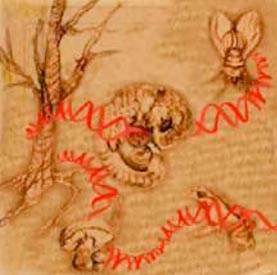Concept 40 Living things share common genes.

All living organisms store genetic information using the same molecules — DNA and RNA. Written in the genetic code of these molecules is compelling evidence of the shared ancestry of all living things. Evolution of higher life forms requires the development of new genes to support different body plans and types of nutrition. Even so, complex organisms retain many genes that govern core metabolic functions carried over from their primitive past.
Genes are maintained over an organism's evolution, however, genes can also be exchanged or "stolen" from other organisms. Bacteria can exchange plasmids carrying antibiotic resistance genes through conjugation, and viruses can insert their genes into host cells. Some mammalian genes have also been adopted by viruses and later passed onto other mammalian hosts. Regardless of how an organism gets and retains a gene, regions essential for the correct function of the protein are always conserved. Some mutations can accumulate in non-essential regions; these mutations are an overall history of the evolutionary life of a gene.
 DNA is packaged in a chromosome.
DNA is packaged in a chromosome. Higher cells incorporate an ancient chromosome.
Higher cells incorporate an ancient chromosome. Some DNA does not encode protein.
Some DNA does not encode protein. Some DNA can jump.
Some DNA can jump. Genes can be turned on and off.
Genes can be turned on and off. Genes can be moved between species.
Genes can be moved between species. DNA responds to signals from outside the cell.
DNA responds to signals from outside the cell. Different genes are active in different kinds of cells.
Different genes are active in different kinds of cells. Master genes control basic body plans.
Master genes control basic body plans. Development balances cell growth and death.
Development balances cell growth and death. A genome is an entire set of genes.
A genome is an entire set of genes. Living things share common genes.
Living things share common genes. DNA is only the beginning for understanding the human genome.
DNA is only the beginning for understanding the human genome.